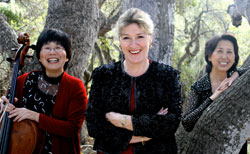Faculty Activities
David Arrivée
David Arrivée keeps himself busy each summer by serving as the associate conductor of Festival Mozaic (formerly the San Luis Obispo Mozart Festival). Last summer, he led the Festival Orchestra in a performance of Beethoven’s Violin Concerto, while Music Director Scott Yoo played the solo part. In addition, he directed the Festival Brass in a concert of Renaissance music and conducted the Festival String Orchestra in a program of musical homages. He looks forward to more great music in the coming summer.
Ken Habib
In addition to teaching during the academic year, ethnomusicology professor Habib has also served on the faculty of the Middlebury College Arabic School during the summer. With a distinguished history dating to 1915, the Middlebury College Language Schools have grown to 10 in number: Arabic, Chinese, French, German, Hebrew, Italian, Japanese, Portuguese, Russian and Spanish. In response to increasing demand for admission to the language schools, the Arabic, French, Italian and Spanish Schools are taking up residence at Mills College starting in summer 2009. The fit between the two top liberal arts colleges — Middlebury College, founded in Vermont in 1800, and Mills College, founded in California in 1852 — appears ideal and represents a historic development in language education in the country. Every summer, students and faculty from around the world descend on their respective language school for an intensive immersion program. Students take the Language Pledge — a promise to use only their language of study for the duration of the program, which in the case of the Arabic School is nine weeks. In addition to being in class together, students and faculty eat together, engage in cocurricular activities together, live in the same dorm together, and where Habib is concerned, play music together. In addition to looking forward to the rich cultural climate of the San Francisco Bay Area this summer with the move of the Middlebury College Arabic School to Mills College, Habib is notably looking forward to eluding the voracious swarms of Vermont mosquitoes known all too well for sending their human cohabitants running for cover.
Jacalyn Kreitzer

Nancy Nagano, Jacalyn Kreitzer and Kiyomi Kato
The “Kreitzer Ensemble,” with Jacalyn Kreitzer, mezzo-soprano,
Nancy Nagano, cello, and Kiyomi Kato, piano, performed in recital
in Barocksaal Hall in Kyoto, Japan, last spring, and for the Consul
General of Japan, Junichi Makiko, and the Japanese Consulate
in the fall. There are a great number of works written
for this beautiful instrumentation. The Trio offers compositions by
Alessandro Scarlatti, Johannes Brahms, Charles Loeffler,
Hector Berlioz, Andre Previn, and Leonard Bernstein.
Jacalyn Kreitzer will sing the role of Maria Aegyptiaca in Gustav Mahler’s Symphony No. 8 in E-flat major in Colorado with the Boulder Symphony in May 2009. Known as the “Symphony of a Thousand,” the work calls for a 100-piece orchestra, two mixed choirs and a boys’ choir. It will be conducted by Robert Olson. Soloists in addition to Kreitzer include Thomas Hampson and Vincent Cole. Kreitzer says this is her favorite work, but one she has only been able to perform four times in her career due to its monumental production costs.
She was first introduced to the work by the Austrian-born and exacting conductor Erich Leinsdorf (1912-1993), who she met through her teacher Herta Glaz (1931-2006), in Bel Air, Calif. Viennese-born, many of Herta’s first concerts in the United States were as a mezzo soloist in Mahler’s third and eighth symphonies, conducted by Leinsdorf and Otto Klemperer, with the Los Angeles Philharmonic.
Alyson McLamore
“The Quest for NASM Renewal” has been the centerpiece of McLamore’s fall and winter quarters, as she chairs the Steering Committee that is overseeing the Music Department’s bid for reaccreditation with the National Association of Schools of Music. Like all her colleagues, she looks forward to the evaluation visit in mid-May, which will allow the department to demonstrate the strengths of the bachelor’s degree program and to receive suggestions for improvement.
Among the strengths of the program are, of course, the students, and McLamore has been delighted with major and non-major courses she has taught since her return from sabbatical, as well as the many senior projects that are in preparation for presentation later this spring. Not only have student performances enriched some of McLamore’s general education courses, such as Musical Theater and Women in Music, but also students (and former students) have returned (voluntarily!) to the music major history series to give guest lecture presentations.
Outside of the classroom, one of the general education courses (History of Film Music) has led McLamore to develop a set of rubrics that students can use in analyzing the specific ways in which music can function within a movie, and she has given a presentation discussing this analytical tool at a meeting of the Pacific Southwest Chapter of the American Musicological Society, held jointly with the Musicological Film Studies Symposium. McLamore is also presenting a talk, “Stone Walls and Glass Ceilings: Why is it So Hard to be a Woman Composer?” at the April district convention of Tau Beta Sigma, a national honorary band sorority. Her essay “Harmony and Discord: Points of Collision in the Wesley Family Concerts” will be published in the collection Music and the Wesleys (edited by Nicholas Temperley and Stephen Banfield), forthcoming from the University of Illinois Press. Meanwhile, she continues to write program notes for the San Luis Obispo Symphony, the Cuesta Master Chorale, and the Festival Mozaic.

